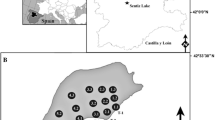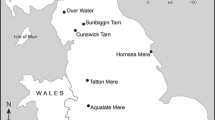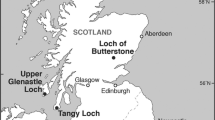Abstract
We explored spatial and temporal relationships between contemporary aquatic vegetation and surface sediment macrofossil remains in a small, shallow, English lake (Green Plantation Pond). The aquatic vegetation of Green Plantation Pond underwent a marked compositional change after 2005 with a shift from Elodea spp.-Potamogeton pusillus-Chara spp. to Ceratophyllum spp.-Chara spp.-Potamogeton crispus dominance. By comparing macrophyte and plant macrofossil distributions at multiple, closely spaced points in Green Plantation Pond for 2000 and 2008–2009, we studied the ability of macrofossils to track this major aquatic vegetation change. Representation of macrophytes by macrofossils was high with 63 and 76 % of extant plant species recorded by macro-remains in the 2000 and 2009 sediment surveys respectively. Nevertheless, plants were both over-represented (Nitella flexilis, Chara spp. and Zannichellia palustris) and under-represented (Ranunculus sect. Batrachium, Potamogeton spp.) in the sediment record in terms of relative macrofossil abundances and the number of occupied sample points. The study also revealed a lack of preservation of Elodea spp. leaf remains in the second (2009) survey compared to the first (2000) probably due to a longer time interval (5 vs. 10 months) between macrophyte and sediment sampling. Nevertheless, the macrofossils reliably recorded both the main shift in the contemporary vegetation (e.g. especially increases in Ceratophyllum spp. and P. crispus abundance) and other more subtle floristic changes (e.g. increases in Myriophyllum spicatum and Lemna spp.) exceptionally well. This study highlights the huge potential of macrofossils for tracking sub-decadal changes in the aquatic vegetation of small, shallow lakes.



Similar content being viewed by others
References
Barrat-Segretain MH (1996) Strategies of reproduction, dispersion, and competition in river plants: a review. Vegetatio 123:13–37
Beijerinck W (1976) Zadenatlas der Nederlandsche Flora. Backhuys and Meesters, Amsterdam
Beltman B, Allegrini C (1997) Restoration of lost aquatic plant communities: new habitats for Chara. Neth J Aquat Ecol 30:331–337
Berggren G (1964) Atlas of Seeds, Part 2. Cyperaceae. Swedish Natural Science Research Council, Stockholm
Berggren G (1981) Atlas of Seeds, Part 3. Salicaceae–Cruciferae. Swedish Museum of Natural History, Stockholm
Birks HH (1973) Modern macrofossil assemblages in lake sediments in Minnesota. In: Birks HJB, West RG (eds) Quaternary plant ecology. Blackwell, Oxford, pp 173–190
Birks HH (1980) Plant macrofossils in Quaternary lake sediments. Arch Hydrobiol 15:1–60
Birks HH (2001) Plant macrofossils. In: Smol JP et al (eds) Tracking Environmental Change Using Lake Sediments. Vol 3. Terrestrial, Algal and Siliceous Indicators. Kluwer, Dordrecht, pp 49–74
Birks HH (2007) Plant macrofossil introduction. In: Scott AE (ed) Encyclopedia of Quaternary Science, vol 3. Elsevier, Amsterdam, pp 2,266–2,288
Bonis A, Grillas P (2002) Deposition, germination and spatio-temporal patterns of charophyte propagule banks: a review. Aquat Bot 72:235–248
Bray JR, Curtis JT (1957) An ordination of the upland forest communities of southern Wisconsin. Ecol Monogr 27:325–349
Brodersen KP, Odgaard BV, Vestergaard O, Anderson NJ (2001) Lake Søbygaard, Denmark: chironomid–macrophyte co-occurrence. Freshw Biol 46:253–267
Canfield DE Jr, Shireman JV, Colle DE, Haller WT, Watkins CE, Maceina MJ (1984) Predication of chlorophyll a concentrations in Florida lakes: importance of aquatic macrophytes. Can J Fisheries Aquat Sci 41:497–501
Carpenter SR, Lodge DM (1986) Effects of submersed macrophytes on ecosystem processes. Aquat Bot 26:341–370
Casanova MT, Brock MA (1990) Germination and establishment of charophytes from the seed bank of an Australian temporary lake. Aquat Bot 36:247–254
Casanova MT, Brock MA (1996) Can oospore germination patterns explain charophyte distribution in permanent and temporary wetlands? Aquat Bot 54:297–312
Davidson TA, Sayer CD, Bennion H, David C, Rose N, Wade MP (2005) A 250 year comparison of historical, macrofossil and pollen records of aquatic plants in a shallow lake. Freshw Biol 50:1,671–1,684
Davis FW (1985) Historical changes in the submerged macrophyte communities of Chesapeake Bay. Ecology 66:981–993
Dieffenbacher-Krall AC (2007) Plant macrofossil methods and studies. Surface samples, taphonomy, representation. In: Scott AE (ed) Encyclopedia of Quaternary Science, vol 3. Elsevier, Amsterdam, pp 2,367–2,374
Dieffenbacher-Krall AC, Halteman WA (2000) The relationship of modern plant remains to water depth in alkaline lakes in New England, USA. J Paleolimnol 24:213–229
Diggerfeldt G (1988) Reconstruction and regional correlation of Holocene lake-level fluctuations in Lake Bysjön, south Sweden. Boreas 68:1–11
Dudley B, Gunn IDM, Carvalho L, Proctor I, O’Hare MT, Murphy KJ, Milligan A (2012) Changes in aquatic macrophyte communities in Loch Leven: evidence of recovery from eutrophication? Hydrobiol 681:49–57
Duigan C, Kovach W, Palmer M (2007) Vegetation communities of British lakes: a revised classification scheme for conservation. Aquat Conserv: Marine Freshw Ecosyst 17:147–173
ESRI (Environmental Systems Resource Institute) (2006) ArcMap 9.2. ESRI. Redlands, California
Glew JR (1991) Miniature gravity corer for recovering short sediment cores. J Paleolimnol 5:285–287
Grace JB, Wetzel RG (1978) The Production Biology of Eurasian Watermilfoil (Myriophyllum spicatum L.): a Review. J Aquat Plant Manag 16:1–11
Hannon GE, Gaillard MJ (1997) The plant macrofossil record of past lake-level change. J Paleolimnol 18:15–28
Heggen MP, Birks HH, Heiri O, Grytnes J-A, Birks HJB (2012) Are fossil assemblages in a single sediment core from a small lake representative of total deposition of mite, chironomid, and plant macrofossil remains? J Paleolimnol 48:669–691
Hill MO, Preston CD, Roy DB (2004) PLANTATT. Attributes of British and Irish Plants: Status, Size, Life History, Geography and Habitats. Centre for Ecology and Hydrology, NERC, Oxford
Jeppesen E, Lauridson TL, Kairesalo T, Perrow (1997) Impact of submerged macrophytes on fish-zooplankton interactions in lakes. In: Jeppesen E, Søndergaard MO, Søndergaard MA, Christofferson K (eds) The structuring role of submerged macrophytes in lakes. Ecological Studies 131. Springer, New York, pp 91–141
Jeppesen E, Søndergaard M, Meerhoff M, Lauridsen TL, Jensen JP (2007) Shallow lake restoration by nutrient loading reduction—some recent findings and challenges ahead. Shallow lakes in a changing world. Develop Hydrobiol 196:239–252
Koff T, Vandel E (2008) Spatial distribution of macrofossil assemblages in surface sediments of two small lakes in Estonia. Estonian J Ecol 57:5–20
Madgwick G, Emson D, Sayer CD, Willby NJ, Rose N, Jackson MJ, Kelly A (2011) Centennial-scale changes to the aquatic vegetation structure of a shallow eutrophic lake and implications for restoration. Freshw Biol 56:2,620–2,636
Mäemets H, Freiberg L (2005) Long- and short-term changes of the macrophyte vegetation in a strongly stratified hypertrophic Lake Verevi. Hydrobiologia 547:175–184
Minchin PR (1987) An evaluation of relative robustness of techniques for ecological ordinations. Vegetatio 69:89–107
Patmore IR, Sayer CD, Goldsmith B, Davidson TA, Rawcliffe R, Salgado J (2013) Big Ben: a new wide-bore piston corer for multi-proxy palaeolimnology. J Paleolimnol. doi:10.1007/s10933-013-9756-0
Preston CD (1995) Pondweeds of Great Britain and Ireland. Botanical Society of the British Isles, London
Rasmussen P, Anderson NJ (2005) Natural and anthropogenic forcing of aquatic macrophyte development in a shallow Danish Lake during the last 7000 years. J Biogeogr 32:1,993–2,005
Roelofs JGM (1983) Impact of acidification and eutrophication on macrophyte communities in soft waters in The Netherlands I. Field observations. Aquat Bot 17:139–155
Salgado J, Sayer CD, Carvalho L, Davidson TA, Gunn I (2010) Assessing aquatic macrophyte community change through the integration of palaeolimnological and historical data at Loch Leven, Scotland. J Paleolimnol 43:191–204
Sand-Jensen K, Riis T, Vestergaard O, Larsen SE (2000) Macrophyte decline in Danish lakes and streams over the past 100 years. J Ecol 88:1,030–1,040
Sayer CD, Burgess A, Kari K, Davidson TA, Peglar S, Yang H, Rose N (2010) Long-term dynamics of submerged macrophytes and algae in a small and shallow, eutrophic lake: implications for the stability of the macrophyte-dominated state. Freshw Biol 55:565–583
Sayer CD, Bennion H, Davidson TA, Burgess A, Clarke G, Hoare D, Frings P, Hatton-Ellis T (2012) The application of palaeolimnology to evidence-based lake management and conservation: examples from UK lakes. Aquat Conserv: Marine Freshw Ecosyst 22:165–180
Schaumburg J, Schranz C, Hofmann G, Stelzer D, Schneider S, Schmedtje U (2004) Macrophytes and phytobenthos as indicators of ecological status in German lakes- a contribution to the implementation of the water framework directive. Limnol—Ecol Manag Inland Waters 34:302–314
Simons J, Ohm M, Daalder R, Boer P, Rip W (1994) Restoration of Botshol (The Netherlands) by reduction of external nutrient load: recovery of Characean community dominated by Chara connivens. Hydrobiologia 275(276):243–253
Søndergaard M, Jeppesen E, Jensen JP, Amsinck SL (2005) Water Framework Directive: ecological classification of Danish lakes. J Appl Ecol 42:616–629
Stace CA (1997) New flora of the British Isles, 2nd edn. Cambridge University Press, Cambridge
Väliranta MM (2006) Long-term changes in aquatic plant species composition in North-eastern European Russia and Finnish Lapland, as evidence by plant macrofossil analysis. Aquat Bot 85:224–232
Wilcox DA, Meeker JE (1991) Disturbance effects on aquatic vegetation in regulated and unregulated lakes in northern Minnesota. Can J Bot 69:1,542–1,551
Yeo RR (1966) Yields of propagules of certain aquatic plants. Weeds 14:110–113
Zhao Y, Sayer CD, Birks HH, Peglar SM, Hughes M (2006) Spatial representation of aquatic vegetation by macrofossil and pollen remains in a small and shallow lake. J Paleolimnol 35:35–350
Acknowledgments
We would like to thank Nicholas Deterding, David Tabrett and the Kelling estate for allowing access to Green Plantation Pond. Tom Davidson, Ruth Rawcliffe, Pete “The Map” Robinson, Ian and Annie Morrissey, Jo Atherton, Ginnie Panizzo, Dave and Daksha Emson, Derek Sayer and Terry Linford are thanked for field assistance at Green Plantation Pond over many years. We are also grateful to Nick Stewart for kindly providing the charophyte identifications and to Miles Irving for the production of Fig. 1. This paper was written with support to Gina Clarke and Carl Sayer from the European Union FP7 project ‘BIOFRESH’ (Contract No. 226874). We would like to take this opportunity to thank Hilary Birks for her considerable assistance with macrofossil-based research in the Environmental Change Research Centre (ECRC), UCL, including the teaching of a long-running (15 years) and very successful short course on macrofossil analysis, assistance with establishing the UCL macrofossil reference collection and considerable help and advice to ECRC members over many years. Thank you so much Hilary, for all of this help, and for inspiring a new generation of dedicated “macrofossilers”. We dedicate this paper to you.
Author information
Authors and Affiliations
Corresponding author
Additional information
Communicated by K. J. Willis.
Rights and permissions
About this article
Cite this article
Clarke, G.H., Sayer, C.D., Turner, S. et al. Representation of aquatic vegetation change by plant macrofossils in a small and shallow freshwater lake. Veget Hist Archaeobot 23, 265–276 (2014). https://doi.org/10.1007/s00334-013-0427-x
Received:
Accepted:
Published:
Issue Date:
DOI: https://doi.org/10.1007/s00334-013-0427-x




